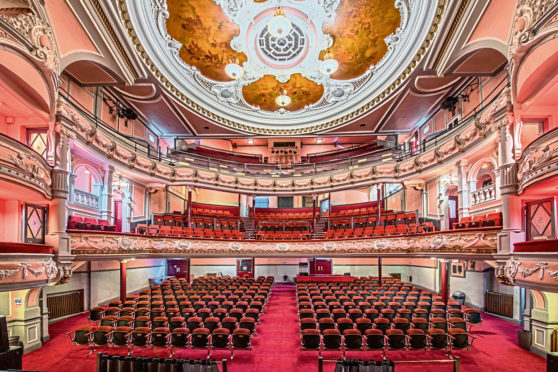Stepping into the auditorium of the historic Tivoli theatre in Aberdeen was definitely a “wow” moment.
The ongoing transformation of the Guild Street venue following decades of neglect seemed to me to be another sign of a cultural renaissance taking place in the Granite City.
Aberdeen’s oldest existing theatre was in terminal decline when businessman Brian Hendry rescued it in 2009, with a dream of restoring it to its former glory. The building, which was used as a bingo hall at one stage, had lain empty for years.
Mr Hendry persuaded the current shareholders – Scotland football team manager Alex McLeish, hotelier Stewart Spence and Ian Thomson, of the Thomson Management consultancy – to come on board.
There was a grant available to quickly make the building wind and watertight but the interior was to take another five years and more than £1million to put right.
Cleaning the ornate Victorian ceiling was a major task in itself – years of smoke from people puffing away on cigarettes during variety shows had left it badly nicotine-stained.
The 146-year-old theatre – one of Scotland’s most historic Grade A-listed buildings – is now firmly at the heart of Aberdeen’s cultural offering.
It has a varied programme for 2018, with concerts, musicals, stand-up comedy shows, a pantomime and Hogmanay party all in the line-up from June to December.
But staging a growing number of events and ongoing work to further improve the facilities involves more than time and effort, of course.
A large and growing band of corporate and private sponsors highlight the key role played by local businesses, while the theatre’s owners are also targeting other potential sources of financial support.
Mr Thomson said: “The shareholders’ vision is for the theatre to continue attracting audiences from throughout the north-east with a variety of performance genres suited to our unique venue.
“We trust that the city fathers share our vision to maintain this iconic arts arena by lending their support, where possible, alongside the alternatives that attract substantial external funding.”
The theatre’s 528-seat auditorium was opened in stages, with the first production – Inferno, a play by Thomas Bywater, taking place in front of 100 people in October 2013.
Pantomime made its long-awaited return to the Tivoli later the same year .
Attic Theatre’s Robin Hood and the Babes in the Wood was the first panto to take place at the theatre in 50 years.
All three levels of the auditorium are now open and as the capacity has increased, the Tivoli has also developed a strong partnership with local production company Attic.
The drama group’s 2017 production of Cinderella was watched by more than 8,000 people and bosses are predicting an even bigger number will take in Peter Pan after it opens later this year.
Aberdeen Youth Music Theatre produces three separate shows a year which gives their juniors, intermediates and seniors a chance to take the stage for a week during the months of March, May and June.
The Tivoli also has a strong relationship with Aberdeen Academy of Performing Arts (AAPA), which hosted a three-day dance competition at the venue earlier this year.
More than 300 people attended the AAPA event, including parents and children.
In October, the Tivoli will be the main venue for Aberdeen Inspired’s Comedy Festival.
The theatre was also a host venue during Aberdeen Performing Arts’ True North Festival and Aberdeen International Youth Festival.
In addition, it holds corporate and private functions and has hosted an election hustings event.
The Tivoli regularly accepts exhibitions from local artists, using its fascinating museum room to showcase their work.
Around 26,000 people visited the theatre during the 12 months to the end of October 2017, while other milestones last year included the venue obtaining a full licence for its three bars.
Wi-Fi was installed throughout the theatre and all the technical equipment was acquired out of a long-term lease, adding about £100,000 to the Tivoli’s asset value.
Students from North East Scotland College recently helped create a new logo for the theatre as part of a rebranding exercise.
General manager Caroline Morgan said the aim was to put on many more shows to “fill the days when we don’t have anything” and to secure long-term financial viability for the business.
Ms Morgan is part of a small management team which also includes Christina Camillo and Lynn Sangster.
The trio hope the Tivoli will benefit, along with a revamped Music Hall, refurbished Aberdeen Art Gallery and His Majesty’s Theatre, from an influx of tourists as the Granite City diversifies its economy from one highly dependent on the oil and gas industry.
Aberdeen’s rapidly growing reputation for the arts – boosted by recent events like the Nuart street art festival – and increased awareness about the city’s other attractions are also expected to help drive up audience numbers.
Ms Morgan said: “We’re getting many more phone calls from people asking what’s on at the theatre. The word is out there about the Tivoli.”
The theatre was founded in 1872 as Her Majesty’s Opera House and designed by James Matthews and CJ Phipps.
It was improved and redeveloped in 1897 and 1909 by renowned architect Frank Matcham, but then closed temporarily in 1906 after the opening of the larger His Majesty’s Theatre.
Reopening in 1910 as the Tivoli Theatre of Varieties, the venue hosted some of the world’s best-known performers.
Charlie Chaplin, Stan Laurel and WC Fields were among the celerities to grace its stage.
The building continued to cater for theatre-going audiences until 1966, when the main auditorium went into use as a bingo hall.
Plans were put forward to improve the facilities during the 1980s but little was done.
After closing its doors again in 1997, the Tivoli fell into disrepair and was listed on the risk register as “critical”.
Former Aberdeen FC star McLeish got involved in the revival plans saying he hoped the Tivoli revamp would act as a catalyst for further regeneration of the city centre.
